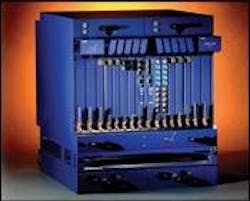Photuris to launch integrated WDM/TDM system at NFOEC
By MEGHAN FULLER
Photuris (Piscataway, NJ) has been in stealth mode since its inception in January 2000. During that time, company representatives sat down with their potential carrier customers, and they asked a lot of questions. They listened. They took notes. And they built a system specifically designed to meet those carriers' requirements and-perhaps most important-their price points. The V32000 Optical Distribution System will make its debut at NFOEC in Dallas this month-but while the system may be ready, is the market ready for the system?The V32000 is optimized for the metro core/metro regional or interoffice network, which is typically about 50 to 500 km in circumference and has a unique set of requirements, explains Ashish Vengsarkar, company co-founder and vice president of product marketing.
"When we probed our customers, we found that there were five key things that we had to satisfy in order to meet their needs," he reveals. The carriers wanted a flexible, programmable optical add/drop multiplexer (OADM) for ring applications; judicious layer integration of WDM/ TDM transport; an integrated data-over-transport system; per-wavelength-selectable protection; and a Generalized MPLS-based control plane for distributed network control. The system features a reconfigurable OADM that provides single wavelength granularity and real-time remote provisioning. "In es sence, we're allowing carriers to do with wavelengths what they are used to doing with STS-1s and SONET systems, which is be able to remotely configure them," asserts Paul Bonenfant, chief architect of the V32000.
Another highlight of the system is its one-time node engineering capability, which allows a carrier to design an optical ring and never have to visit that node or ring again except to add services or capacity. "It's a cookie-cutter approach to an OADM like you would have with a SONET ADM today," adds Bonenfant.
Per carrier request, the Photuris system also boasts what the company calls "judicious layer integration-in other words, pick the right level of functionalities from an optical ADM and the SONET ADM and put that together," says Vengsarkar. "The carriers did not want us to build a box that tries to do everything."
The resultant box retains all the key characteristics of the SONET and WDM worlds, according to Photuris, enabling carriers to deliver their "bread and butter" TDM services as well as future services, including wavelength and SAN services.
In addition, carriers asked the folks at Photuris to leverage their existing infrastructure to carry Ficon, Escon, Fibre Channel, and Ethernet. "We also noticed that the services were very diverse," says Vengsarkar, "so they had different types of services in different traffic patterns. They would have hub-like traffic patterns in some areas and mesh-like traffic patterns in other areas." To accommodate such diverse traffic and shifting traffic patterns, Photuris has built-in what it calls "mix-and-match optical layer protection," or per-wavelength-selectable protection. "We've done away with the concept of all-or-nothing ring protection schemes, so you don't have to pick shared protection for a whole ring or dedicated protection for a whole ring," explains Bonenfant. "It is selectable on a per-wavelength basis; it has no impact on engineering rules nor does it impact the selection of OC-48 or OC-192."
The system delivers full automation of the optical layer through proprietary optical subsystems, including the VersiColor optical line card and the VersiColor ADM-on-a-Wavelength line card. "The VersiColor optical line card enables us to take any wavelength from any node to any other node independent of any other wavelength in the system without restrictions and without compromises on the engineering rules of the system," notes Bonenfant. The VersiColor ADM-on-a-Wavelength line cards allow Photuris to build a fully GR.253-compliant SONET ADM terminal in a pair of line cards, supporting any mix of OC-3, -12, -48, and -192.
Integration: An easy sell?
While the V32000 may be a carriers' dream, the current economic climate may force many to keep dreaming. Integration provides key advantages in terms of synergy, but it can also put a vendor at a disadvantage-particularly in today's market. "It implies that you've got a customer that is ready, willing, and needs to upgrade some of the legacy equipment as well as some of the transport at that same time-which is more money, which, right now, is not an easy sell," reasons David Dunphy, principal analyst, optical infrastructure at Current Analysis (Sterling, VA). "But this applies to integration of anything."
Photuris certainly faces its share of competition from the likes of Meriton, PhotonEx, and others. Regardless, the company is moving full steam ahead, confident that its system can deliver what the carriers need. The V32000 has already passed NEBS level 3 testing and is well into the OSMINE process. The company expects to have certification by the fourth quarter, and carrier trials are either underway or pending. "They've been promising that provisioning synergies are going to be pretty significant from a cost perspective," says Dunphy, "and they've been talking about a 30-40% reduction in how much time it would take to make a change remotely. That's going to buy them a lot of interest. Now we need to see some form of trials."

